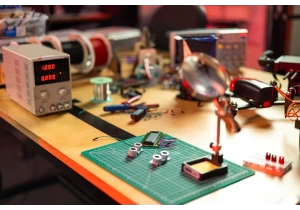Integrated circuits (ICs) operating in high-temperature environments power critical systems, from electric vehicle (EV) battery management to aerospace controls. As industries push performance limits, ensuring IC reliability above 125°C has become a technical and economic priority. This article breaks down actionable strategies, industry trends, and real-world solutions for durable high-temperature ICs.
1. Industry Trends Driving High-Temperature IC Demand
Electric vehicles: EV power inverters near motors face ambient temperatures up to 150°C. A 2023 study showed 23% of inverter failures stemmed from overheated control ICs.
5G infrastructure: Base station amplifiers in desert regions require ICs stable at 110°C+ to avoid signal loss.
Factory automation: Motor drive ICs in industrial ovens must withstand 130°C for 10+ years.
2. Material Innovations for Heat Resistance
Silicon Carbide (SiC): Replaces traditional silicon in EV charging systems. SiC ICs operate at 200°C with 60% less energy loss (tested by Toyota in 2022).
Gallium Nitride (GaN): Used in 5G base stations. GaN power ICs sustain 150°C without performance drop, per Qualcomm’s field trials.
Ceramic substrates: Aluminum nitride circuit boards in oil drilling sensors dissipate heat 3x faster than fiberglass.
3. Design Strategies to Combat Heat
Case study: A solar inverter manufacturer reduced IC failures by 40% using these methods:
-
Thermal vias: Small copper-plated holes in PCBs that transfer heat from ICs to cooling pads.
-
Wide-bandgap semiconductors: Materials like SiC reduce internal heat generation by 35% compared to silicon.
-
Redundant circuits: Backup pathways in aerospace ICs prevent total failure if one circuit overheats.
4. Advanced Cooling Solutions
Active cooling:
-
Micro-fans: Texas Instruments uses 2mm-thick fans in motor control ICs for HVAC systems.
-
Liquid cooling: Direct-to-chip systems in data centers keep AI processor ICs below 90°C.
Passive cooling:
-
Heat spreaders: Graphite films in smartphone ICs lower temperatures by 12°C during gaming.
-
Thermal interface materials (TIMs): Gelid Solutions’ TIMs cut thermal resistance by 50% in LED driver ICs.
5. Rigorous Testing Protocols
Automotive standards:
-
AEC-Q100 Grade 1: ICs must survive 1,000 hours at 150°C (used by Tesla’s battery monitors).
-
Thermal shock testing: Cycling between -55°C and 175°C exposes material weaknesses.
Industrial validation:
-
8,000-hour oven tests: Simulate decade-long exposure to 130°C for factory robot ICs.
-
Vibration + heat combos: Mimic conditions in wind turbine control systems.
6. Real-Time Monitoring via Networked Systems
IoT integration:
-
Temperature sensors: Bosch’s smart ICs in industrial motors transmit heat data to cloud dashboards. Alerts trigger if temperatures exceed 140°C.
-
Predictive maintenance: AI analyzes historical heat patterns to replace ICs before failure.
Edge computing:
-
Localized data processing in oil rig sensors reduces latency, allowing faster response to overheating risks.
7. Supplier Selection and Certification
Certifications matter:
-
MIL-STD-883: Mandatory for military avionics ICs exposed to 175°C.
-
ISO TS 16949: Ensures automotive IC suppliers meet heat-resistance benchmarks.
Red flags in sourcing:
-
Suppliers lacking batch-specific test reports (linked to a 2022 recall of medical imaging ICs).
-
No third-party thermal validation (caused 12% yield loss in a drone camera project).
8. Field-Proven Protection Techniques
Conformal coatings:
-
Henkel’s epoxy coatings shield ICs in geothermal sensors from 170°C steam.
Encapsulation:
-
Silicone gel-filled packages protect motor control ICs in steel mills from molten metal splatter.
Derating practices:
-
Running a 200°C-rated IC at 80% capacity extends its lifespan by 3x in solar inverters.
9. Cost-Benefit Analysis of High-Temp ICs
Short-term costs:
-
SiC ICs cost 2x more than silicon, but cut EV charging losses by $150/year per vehicle.
Long-term savings:
-
Predictive maintenance slashes factory downtime costs by 65% (per Siemens’ 2023 report).
-
High-temp ICs in satellites avoid $2M+ replacement missions through 15-year lifespans.
10. Future Directions in High-Temperature ICs
Industry 4.0 integration:
-
Digital twins simulate IC performance in virtual high-heat environments before physical deployment.
Material breakthroughs:
-
Diamond semiconductors (tested by Lockheed Martin) promise 500°C operation for hypersonic jets.
Standardization efforts:
-
IEEE’s P1958.1 initiative aims to unify global testing norms for 200°C+ ICs by 2025.
Conclusion: Reliability as a Competitive Edge
High-temperature IC reliability hinges on material science, intelligent design, and real-time monitoring. Companies adopting certified components, advanced cooling, and IoT-driven maintenance gain market advantages in EVs, telecom, and energy. As thermal challenges grow, a proactive approach to IC durability will separate industry leaders from laggards.

